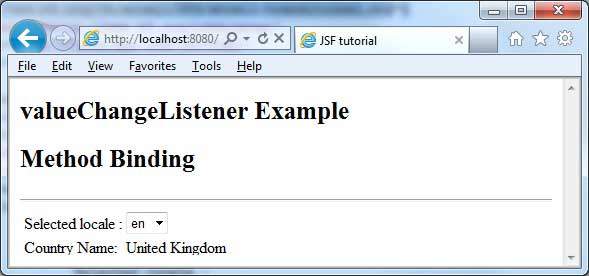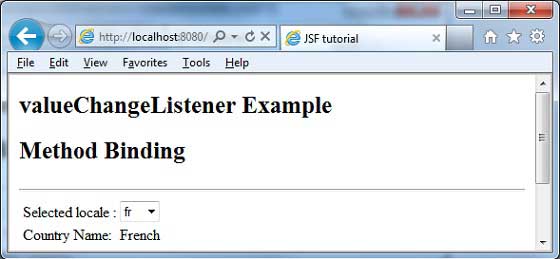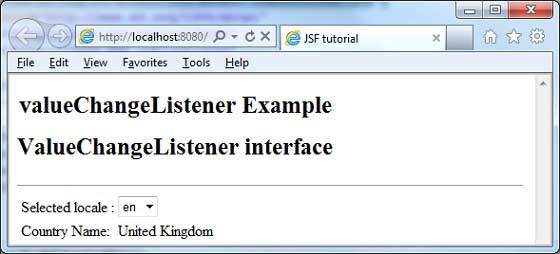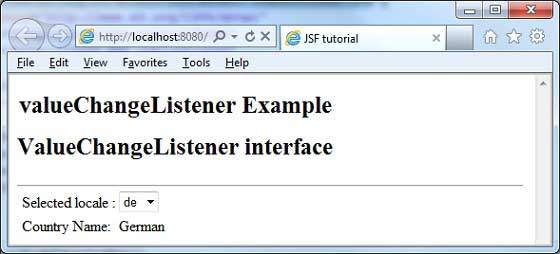
- JSF Tutorial
- JSF - Home
- JSF - Overview
- JSF - Environment Setup
- JSF - Architecture
- JSF - Life Cycle
- JSF - First Application
- JSF - Managed Beans
- JSF - Page Navigation
- JSF - Basic Tags
- JSF - Facelet Tags
- JSF - Convertor Tags
- JSF - Validator Tags
- JSF - DataTable
- JSF - Composite Components
- JSF - Ajax
- JSF - Event Handling
- JSF - JDBC Integration
- JSF - Spring Integration
- JSF - Expression Language
- JSF - Internationalization
- JSF Useful Resources
- JSF - Quick Guide
- JSF - Useful Resources
- JSF - Discussion
JSF - valueChangeListener
When the user interacts with input components, such as h:inputText or h:selectOneMenu, the JSF fires a valueChangeEvent, which can be handled in two ways.
| S.No | Technique & Description |
|---|---|
| 1 | Method Binding Pass the name of the managed bean method in valueChangeListener attribute of UI Component. |
| 2 | ValueChangeListener Implement ValueChangeListener interface and pass the implementation class name to valueChangeListener attribute of UI Component. |
Method Binding
Define a method
public void localeChanged(ValueChangeEvent e) {
//assign new value to country
selectedCountry = e.getNewValue().toString();
}
Use the above method
<h:selectOneMenu value = "#{userData.selectedCountry}" onchange = "submit()"
valueChangeListener = "#{userData.localeChanged}" >
<f:selectItems value = "#{userData.countries}" />
</h:selectOneMenu>
ValueChangeListener
Implement ValueChangeListener
public class LocaleChangeListener implements ValueChangeListener {
@Override
public void processValueChange(ValueChangeEvent event)
throws AbortProcessingException {
//access country bean directly
UserData userData = (UserData) FacesContext.getCurrentInstance().
getExternalContext().getSessionMap().get("userData");
userData.setSelectedCountry(event.getNewValue().toString());
}
}
Use listener method
<h:selectOneMenu value = "#{userData.selectedCountry}" onchange = "submit()">
<f:valueChangeListener type = "com.tutorialspoint.test.LocaleChangeListener"
/>
<f:selectItems value = "#{userData.countries}" />
</h:selectOneMenu>
Example Application
Let us create a test JSF application to test the valueChangeListener in JSF.
| Step | Description |
|---|---|
| 1 | Create a project with a name helloworld under a package com.tutorialspoint.test as explained in the JSF - First Application chapter. |
| 2 | Modify UserData.java file as explained below. |
| 3 | Create LocaleChangeListener.java file under a package com.tutorialspoint.test. Modify it as explained below. |
| 4 | Modify home.xhtml as explained below. Keep the rest of the files unchanged. |
| 5 | Compile and run the application to make sure the business logic is working as per the requirements. |
| 6 | Finally, build the application in the form of war file and deploy it in Apache Tomcat Webserver. |
| 7 | Launch your web application using appropriate URL as explained below in the last step. |
UserData.java
package com.tutorialspoint.test;
import java.io.Serializable;
import java.util.LinkedHashMap;
import java.util.Map;
import javax.faces.bean.ManagedBean;
import javax.faces.bean.SessionScoped;
import javax.faces.event.ValueChangeEvent;
@ManagedBean(name = "userData", eager = true)
@SessionScoped
public class UserData implements Serializable {
private static final long serialVersionUID = 1L;
private static Map<String,String> countryMap;
private String selectedCountry = "United Kingdom"; //default value
static {
countryMap = new LinkedHashMap<String,String>();
countryMap.put("en", "United Kingdom"); //locale, country name
countryMap.put("fr", "French");
countryMap.put("de", "German");
}
public void localeChanged(ValueChangeEvent e) {
//assign new value to country
selectedCountry = e.getNewValue().toString();
}
public Map<String, String> getCountries() {
return countryMap;
}
public String getSelectedCountry() {
return selectedCountry;
}
public void setSelectedCountry(String selectedCountry) {
this.selectedCountry = selectedCountry;
}
}
LocaleChangeListener.java
package com.tutorialspoint.test;
import javax.faces.context.FacesContext;
import javax.faces.event.AbortProcessingException;
import javax.faces.event.ValueChangeEvent;
import javax.faces.event.ValueChangeListener;
public class LocaleChangeListener implements ValueChangeListener {
@Override
public void processValueChange(ValueChangeEvent event)
throws AbortProcessingException {
//access country bean directly
UserData userData = (UserData) FacesContext.getCurrentInstance().
getExternalContext().getSessionMap().get("userData");
userData.setSelectedCountry(event.getNewValue().toString());
}
}
home.xhtml
<?xml version = "1.0" encoding = "UTF-8"?>
<!DOCTYPE html PUBLIC "-//W3C//DTD XHTML 1.0 Transitional//EN"
"http://www.w3.org/TR/xhtml1/DTD/xhtml1-transitional.dtd">
<html xmlns = "http://www.w3.org/1999/xhtml"
xmlns:h = "http://java.sun.com/jsf/html"
xmlns:f = "http://java.sun.com/jsf/core">
<h:head>
<title>JSF tutorial</title>
</h:head>
<h:body>
<h2>valueChangeListener Examples</h2>
<h:form>
<h2>Method Binding</h2>
<hr/>
<h:panelGrid columns = "2">
Selected locale :
<h:selectOneMenu value = "#{userData.selectedCountry}"
onchange = "submit()"
valueChangeListener = "#{userData.localeChanged}" >
<f:selectItems value = "#{userData.countries}" />
</h:selectOneMenu>
Country Name:
<h:outputText id = "country" value = "#{userData.selectedCountry}"
size = "20" />
</h:panelGrid>
</h:form>
</h:body>
</html>
Once you are ready with all the changes done, let us compile and run the application as we did in JSF - First Application chapter. If everything is fine with your application, this will produce the following result.

Select locale. You will see the following result.

Modify home.xhtml again in the deployed directory where you've deployed the application as explained below. Keep the rest of the files unchanged.
home.xhtml
<?xml version = "1.0" encoding = "UTF-8"?>
<!DOCTYPE html PUBLIC "-//W3C//DTD XHTML 1.0 Transitional//EN"
"http://www.w3.org/TR/xhtml1/DTD/xhtml1-transitional.dtd">
<html xmlns = "http://www.w3.org/1999/xhtml"
xmlns:h = "http://java.sun.com/jsf/html"
xmlns:f = "http://java.sun.com/jsf/core">
<h:head>
<title>JSF tutorial</title>
</h:head>
<h:body>
<h2>valueChangeListener Examples</h2>
<h:form>
<h2>ValueChangeListener interface</h2>
<hr/>
<h:panelGrid columns = "2">
Selected locale :
<h:selectOneMenu value = "#{userData.selectedCountry}"
onchange = "submit()">
<f:valueChangeListener
type = "com.tutorialspoint.test.LocaleChangeListener" />
<f:selectItems value = "#{userData.countries}" />
</h:selectOneMenu>
Country Name:
<h:outputText id = "country1" value = "#{userData.selectedCountry}"
size = "20" />
</h:panelGrid>
</h:form>
</h:body>
</html>
Once you are ready with all the changes done, refresh the page in the browser. If everything is fine with your application, this will produce the following result.

Select locale. You will see the following result.
